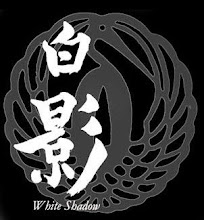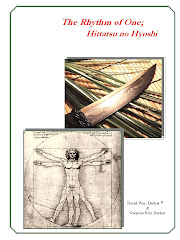
A knife this size is easily carried without creating waves of fear in the general public. There are many general uses for it besides its intended personal defense use. The blade is substantial despite being only 0.145 inches thick. Since they are each custom made the blade lengths vary. One is 4.5 inches and the other is 5 inches. The slender blades are natural piercing weapons but, as you can imagine, no slouch at slicing. The graceful curvature gives the blades the look of a miniature katana. The tsuka (handles) are full tang, copper covered, and then wrapped in epoxy saturated cord. Beneath the tsuka ito wrapping Gary has placed a high quality menuki. The menuki are decorative, but they also create a nice palm swell. Each knife is sheathed in a custom fit kydex sheath with nylon belt loop. Check out Gary’s new website and contact him if you are interested in ordering a custom Japanese style knife. You will not be disappointed that you did.
 http://www.bradburncustomknives.com/
http://www.bradburncustomknives.com/





 Saturday’s shooting was a near repeat of Friday’s except we started shooting at nine o-clock in the morning and moved all the way back to the 800 yard line, one hundred yards at a time. By now we were very grateful for the elevation and windage “Cheat-Sheets” provided by Rod and Danny. These generic sheets allowed us to get on target and then we could dial the scopes in for our individual rifles. By the time we reached 800 yards I wished I was 40 pounds lighter and 20 years younger. The weather was high 80s and humid, winds variable in direction and magnitude. The good news was that I was already beginning to feel more confident with my gear and my skills. My rifle was bought used and it came with a trigger set well under one pound pull, which made it very touchy. I was beginning to learn how to cope with that as well. One of the things that amazed me most was the ability of either instructor to see where your shot hit and immediately give you accurate scope corrections for your rifle. I cannot imagine how many rounds they have both sent down range into targets and under combat conditions. It was an honor to be in the company of men who had been there and done what was required of them.
Saturday’s shooting was a near repeat of Friday’s except we started shooting at nine o-clock in the morning and moved all the way back to the 800 yard line, one hundred yards at a time. By now we were very grateful for the elevation and windage “Cheat-Sheets” provided by Rod and Danny. These generic sheets allowed us to get on target and then we could dial the scopes in for our individual rifles. By the time we reached 800 yards I wished I was 40 pounds lighter and 20 years younger. The weather was high 80s and humid, winds variable in direction and magnitude. The good news was that I was already beginning to feel more confident with my gear and my skills. My rifle was bought used and it came with a trigger set well under one pound pull, which made it very touchy. I was beginning to learn how to cope with that as well. One of the things that amazed me most was the ability of either instructor to see where your shot hit and immediately give you accurate scope corrections for your rifle. I cannot imagine how many rounds they have both sent down range into targets and under combat conditions. It was an honor to be in the company of men who had been there and done what was required of them.
 So what sort of cutlery do I pack? You can rest assured that there are several folders of various quality and size, but nothing costing hundreds of dollars. One smaller bag mollied internally holds a MilTac folder, tactical pen, and a Leatherman tool. Originally I bought a Cold Steel Machete for my BOB but I had forgotten how light weight a machete is. That is nice when you’re looking at pack weight, but sucks when you’re trying to chop firewood, make tent stakes, or split kindling.
So what sort of cutlery do I pack? You can rest assured that there are several folders of various quality and size, but nothing costing hundreds of dollars. One smaller bag mollied internally holds a MilTac folder, tactical pen, and a Leatherman tool. Originally I bought a Cold Steel Machete for my BOB but I had forgotten how light weight a machete is. That is nice when you’re looking at pack weight, but sucks when you’re trying to chop firewood, make tent stakes, or split kindling.






